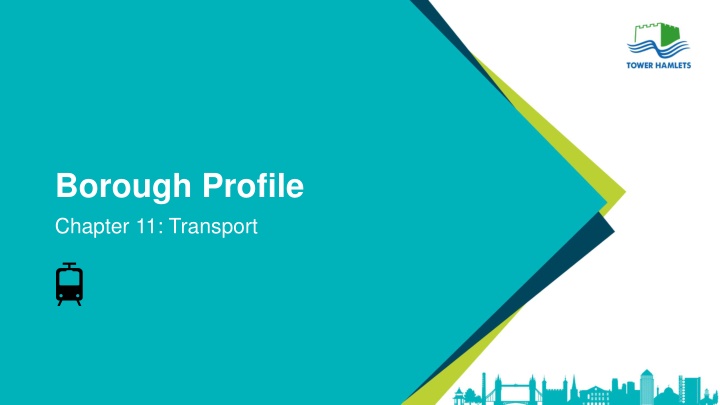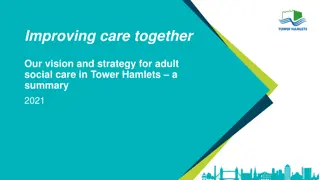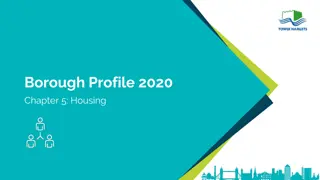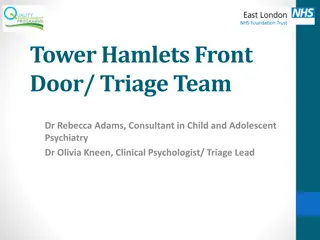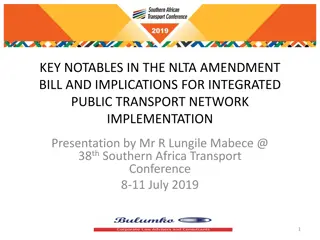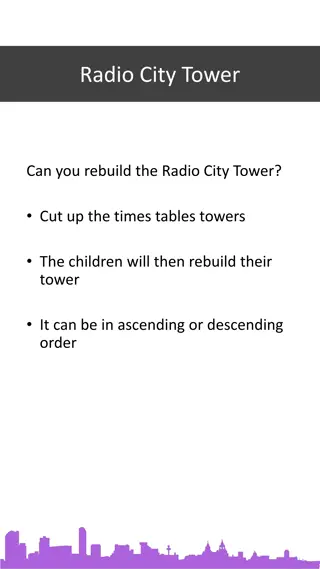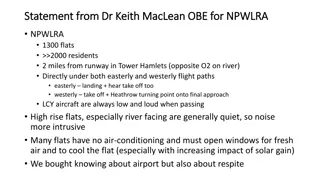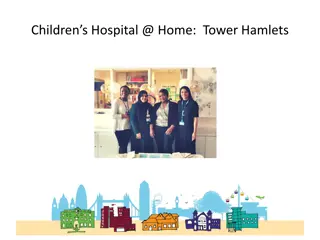Tower Hamlets Transport Network Overview
Tower Hamlets in London has a comprehensive transport network, including Overground, Underground, DLR stations, and bus routes. With low car access, the borough focuses on promoting walking, cycling, and public transport use. Significant growth in rail and tube station entries and exits reflects the area's increasing transport demand.
Download Presentation

Please find below an Image/Link to download the presentation.
The content on the website is provided AS IS for your information and personal use only. It may not be sold, licensed, or shared on other websites without obtaining consent from the author.If you encounter any issues during the download, it is possible that the publisher has removed the file from their server.
You are allowed to download the files provided on this website for personal or commercial use, subject to the condition that they are used lawfully. All files are the property of their respective owners.
The content on the website is provided AS IS for your information and personal use only. It may not be sold, licensed, or shared on other websites without obtaining consent from the author.
E N D
Presentation Transcript
Borough Profile Chapter 11: Transport
Summary Tower Hamlets has an extensive transport network with 7 Overground stations and 9 underground stations, the busiest of which is Canary Wharf station. The borough is also served by 17 DLR stations and 26 daytime bus routes. With 5 percent of residents having access to a car or van at the time of the last census, Tower Hamlets had one of the lowest levels of car access in the country Average speeds on Tower Hamlets A roads are below the average across England and London and decreased between 2015 and 2019. Tower Hamlets has a higher than average proportion of people who walk or cycle on a regular basis, but a low proportion of people cycling for leisure. Future transport developments for Tower Hamlets include the opening of the Elizabeth Line and the implementation of liveable streets across the borough. The liveable streets programme will bring changes to the public realm which aim to promote walking, cycle and use of public transport in place of car usage.
Transport usage - Rail Estimated entries and exits at mainline and London Overground Stations in Tower Hamlets, 2013/14 2018/19 The busiest Overground station in Tower Hamlets is Whitechapel with an estimated 14.4m entries and exits in 2018/19, making it the 32ndbusiest station in Great Britain Between 2013/14 and 2018/19, total transport usage at the borough s seven stations increased by 127% to more than 37m entries and exits, with the greatest increase at Whitechapel (228%) The London Overground line, which runs north to south through the city fringe, has seen particularly high growth in usage. 2013-14 2014-15 2015-16 2016-17 2017-18 2018-19 16,000,000 14,412,690 14,000,000 12,000,000 10,000,000 9,374,284 8,000,000 6,000,000 5,087,054 4,000,000 3,553,990 2,724,584 2,000,000 1,272,734 786,006 0 Bethnal Green Shadwell Cambridge Heath Shoreditch High Street Limehouse Wapping Source: Office of Rail and Road, estimates of station
Transport usage London Underground Tower Hamlets has stations on the Jubilee, Central, District, Circle and Hammersmith and City lines. With 50.9m entries and exits in 2017, Canary Wharf was by far the busiest tube station in Tower Hamlets and was the 9thbusiest station on the London Underground network In total there were 146.8m entries and exits at the 9 tube stations in Tower Hamlets in 2017. Entries and exits at London Underground stations in Tower Hamlets, 2013-2017 60,000,000 50,913,578 50,000,000 40,000,000 30,000,000 21,032,731 20,000,000 13,803,686 10,000,000 6,341,140 3,750,698 - 2013 2014 2015 2016 2017 Aldgate East Bow Road Canary Wharf Stepney Green Bethnal Green Bromley-by-Bow Mile End Tower Hill Source: Transport for London, entry and exit figures by station
Other public transport There are seventeen Docklands Light Railway stations in Tower Hamlets (out of a total of 45 across the network The initial network opened in 1987 to support the regeneration of the London docklands. It has been extended several times since then, improving connections between Tower Hamlets and boroughs to the south and east. Overall, there were 121.8m passenger services in 2018/19 on the DLR network, a rise of 1.8% on the previous year. Tower Hamlets has an extensive bus network with around 26 daytime routes passing through or terminating in the borough. TfL Public Transport Accessibility Level (PTAL) data for 2015 identified good levels of public transport accessibility for the majority of the borough, but with some areas of less good access specifically parts of the Isle of Dogs, the Aberfeldy village area of Poplar and the northern part of Bow. Night Services Canary Wharf station on the Jubilee Line and Wapping, Shadwell, Whitechapel and Shoreditch High Street stations on the TfL London Overground are now served by an all night service on Friday and Saturday nights.
Access to car or van At the time of the 2011 census, 56% of residents in Tower Hamlets did not have access to a car or van. This was the 5thhighest proportion of persons without access to a car in the country (after City of London, Islington, Hackney and Westminster). Access to a car or van by tenure type, 2011 Census. 80% 72% 70% Residents from black ethnic groups were the least likely to have access to a car or van with 65% having no access. Residents from Asian ethnic groups were the most likely to have access to a car with 48% having no access (reducing further to 45% for residents of Bangladeshi ethnicity). 60% 56% 54% 49% 50% 39% 37% 37% 40% 30% 24% 20% Tenure had a significant impact on access to a car a van. Owner occupiers were by far the most likely to have access to a car and van with only 37% having no cars or vans in the household. 54% of residents in social housing did no have access to car or van, while 72% of residents who rented privately or lived rent free did not have access to a car or van. 14% 7% 7% 10% 4% 0% All tenures Owned or shared ownership Social rented Private Rented or living rent free Source: 2011 Census, Tenure by car or van availability No cars or vans in household 1 car or van in household
Road congestion Average speed (mph) on local 'A' roads in England, London and Tower Hamlets The average speed on locally controlled A roads in Tower Hamlets in 2019 was 12.9 miles per hour. This was a decline from 2015 when the average speed on A roads was 14.4 miles per hour. Average road speeds were slower than England (25.3 miles per hour), and slower than London (14.7 miles per hour) but slightly higher than the average for inner London (11.0 miles per hour). 30 25.5 25.3 25 20 16.6 14.7 14.4 15 12.9 12.1 11.0 10 5 0 England London Inner London Tower Hamlets Source: Department for Transport, average speed on local A roads 2015 2019
